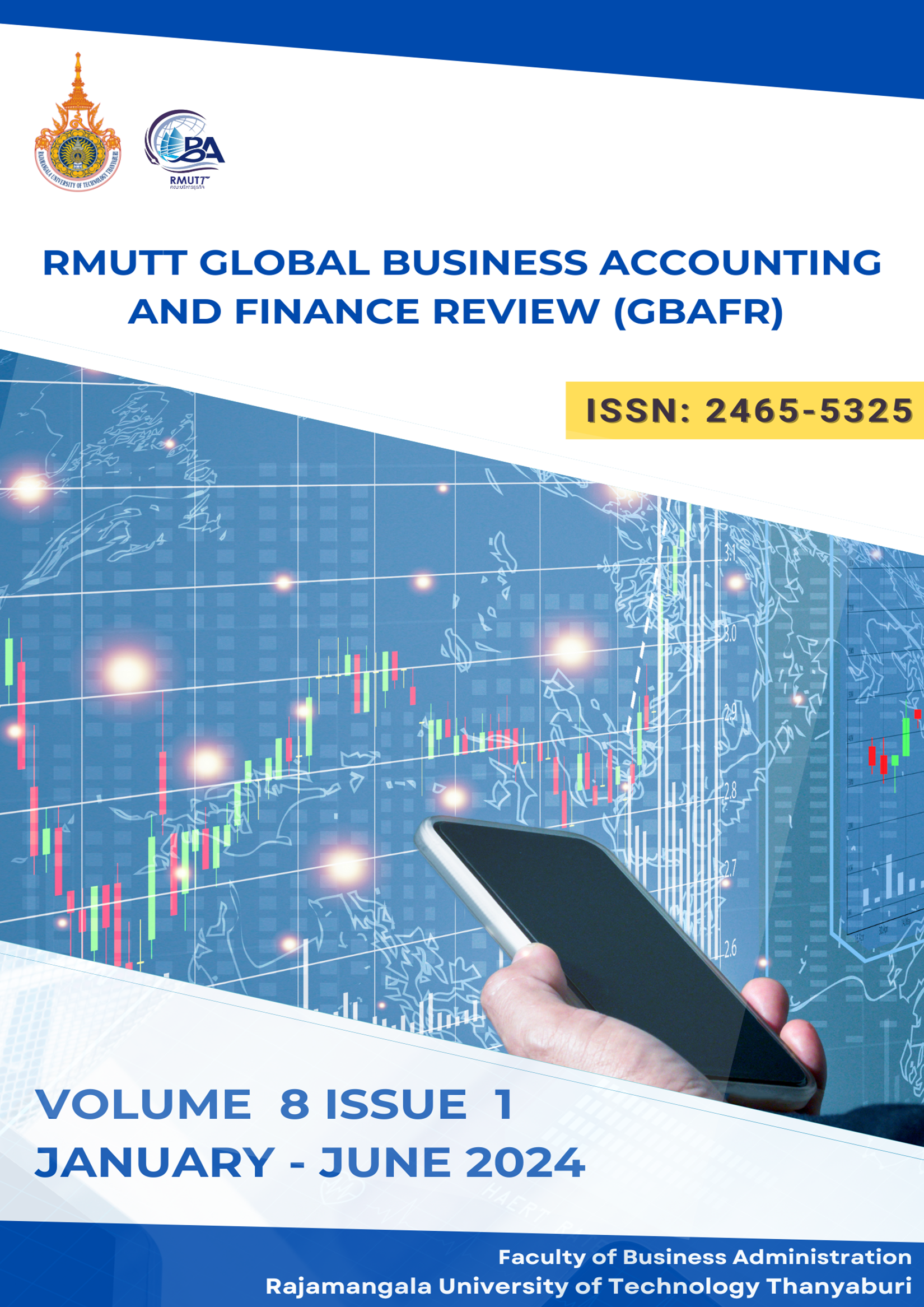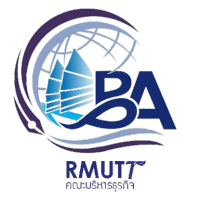FACTORS AFFECTING INTENTION TO USE NATIONAL SINGLE WINDOW (NSW) THROUGH PERCEIVED EASE OF USE AND PERCEIVED USEFULNESS IN IMPORT, EXPORT AND LOGISTICS ENTERPRISES
DOI:
https://doi.org/10.60101/gbafr.2024.272386Keywords:
UTAUT Model, Perceived ease of use, Perceived usefulness, Import, Export, Logistics, National single windowAbstract
Purpose – The purposes of this research were to study factors affecting intention to use National Single Window (NSW) through perceived ease of use and perceived usefulness in import, export, and logistics enterprises.
Methodology – The research methodology was quantitative research with survey method by using questionnaires for data collection. The respondents were 400 participants, who are importers, exporters, and logistics service providers which are located in the Bangkok Metropolitan Region. Descriptive statistics used for data analysis included frequency, percentage, mean, and standard deviation. Due to hypothesis testing, inferential statistics were used, specifically Pearson’s Product Moment Correlation Coefficient and Partial Least Squares-Structural Equation Modeling (PLS-SEM).
Results – The results of hypothesis testing revealed that acceptance and use of technology had a positive and significant effect on perceived ease of use and perceived usefulness whereas organizational support had a positive and significant effect on perceived ease of use, and technology experience had a positive and significant effect on perceived ease of use and perceived usefulness at a significance level of 0.001. In addition, perceived ease of use had a positive and significant effect on perceived usefulness and intention to use, and perceived usefulness had a positive and significant effect on intention to use at a significance level of 0.001. Nevertheless, the results showed that organizational support did not have a significant effect on perceived ease of use. Finally, there were significant indirect effects on the relationships among acceptance and use of technology, perceived ease of use, perceived usefulness, and intention to use.
Implications –The findings present several implications for both academia and management practitioners, providing insights into crafting effective strategies to enhance users’ or employees’ technology adoption once new technologies and/or systems are introduced in the workplace.
Originality/Value – This research sought to enhance comprehensive comprehension of the intricate interplay among the UTAUT Model, perceived ease of use, perceived usefulness, and intention to use, interpreting their collective influence on potential users’ decisions toward the use of systems or IT. Also, the research can fill existing gaps in the literature and provide valuable insights for refining technological capability and competencies, particularly focusing on international entrepreneurship.
References
Abdullah, F., & Ward, R. (2016). Developing a general extended technology acceptance model for e-learning (GETAMEL) by analysing commonly used external factors. Computers in Human Behavior, 56, 238-256.
Abdullah, F., Ward, R., & Ahmed, E. (2016). Investigating the influence of the most commonly used external variables of TAM on students’ Perceived Ease of Use (PEOU) and Perceived Usefulness (PU) of e-portfolios. Computers in Human Behavior, 63, 75-90.
Ajzen, I. (2002). Perceived behavioral control, self-efficacy, locus of control, and the theory of planned behavior. Journal of Applied Social Psychology, 32(4), 665- 683.
Al-rahmi, W. M., Othman, M. S., & Yusuf, L. M. (2015). Using social media for research: The role of interactivity, collaborative learning, and engagement on the performance of students in Malaysian post-secondary institutes. Mediterranean Journal of Social Sciences, 6(5), 536-546.
Alalwan, A. A., Dwivedi, Y. K., Rana, N. P., & Algharabat, R. (2018). Examining factors influencing Jordanian customers’ intentions and adoption of internet banking: Extending UTAUT2 with risk. Journal of Retailing and Consumer Services, 40, 125-138.
Alenezi, A. R., Abdul Karim, A. M., & Veloo, A. (2010). An empirical investigation into the role of enjoyment, computer anxiety, computer self-efficacy and internet experience in influencing the students' intention to use e-learning: A case study from Saudi Arabian governmental universities. Turkish Online Journal of Educational Technology-TOJET, 9(4), 22-34.
Alharbi, S., & Drew, S. (2014). Using the technology acceptance model in understanding academics’ behavioural intention to use learning management systems. International Journal of Advanced Computer Science and Applications, 5, 143-155.
Almaiah, M. A., Alamri, M. M., & Al-Rahmi, W. (2019). Applying the UTAUT model to explain the students’ acceptance of mobile learning system in higher education. Ieee Access, 7, 174673-174686.
Alwahaishi, S., & Snásel, V. (2013). Acceptance and use of information and communications technology: A UTAUT and flow based theoretical model. Journal of Technology Management and Innovation, 8(2), 61-73.
Alyoussef, I. Y. (2022). Acceptance of a flipped classroom to improve university students’ learning: An empirical study on the TAM model and the unified theory of acceptance and use of technology (UTAUT). Heliyon, 8(12), 1-14.
Anandarajan, M., Igbaria, M., & Anakwe, U. P. (2002). IT acceptance in a less-developed country: A motivational factor perspective. International Journal of Information Management, 22(1), 47-65.
Arjang, A., Sutrisno, S., Permana, R. M., Kusumastuti, R., & Ausat, A. M. A. (2023). Strategies for improving the competitiveness of MSMEs through the utilisation of information and communication technology. Al-Buhuts, 19(1), 462-478.
Awa, H. O., Nwibere, B. M., & Inyang, B. J. (2010). The uptake of electronic commerce by SMEs: A Meta theoretical framework expanding the determining constructs of TAM and TOE frameworks. Journal of Global Business & Technology, 6(1), 1-27.
Baabdullah, A., Nasseef, O., & Alalwan, A. (2016). Consumer adoption of mobile government in the Kingdom of Saudi Arabia: The role of usefulness, ease of use, perceived risk and innovativeness. In Social Media: The Good, the Bad, and the Ugly: 15th IFIP WG 6.11 Conference on e-Business, e-Services, and e-Society, I3E 2016, Swansea, UK, September 13–15, 2016, Proceedings 15 (pp. 267-279). Springer International Publishing.
Baganzi, R., & Lau, A. K. (2017). Examining trust and risk in mobile money acceptance in Uganda. Sustainability, 9(12), 2233.
Chao, C. M. (2019). Factors determining the behavioral intention to use mobile learning: An application and extension of the UTAUT model. Frontiers in Psychology, 10, 1652.
Chen, L., & Aklikokou, A. K. (2020). Determinants of E-government adoption: Testing the mediating effects of perceived usefulness and perceived ease of use. International Journal of Public Administration, 43(10), 850-865.
Cigdem, H., & Topcu, A. (2015). Predictors of instructors’ behavioral intention to use learning management system: A Turkish vocational college example. Computers in Human Behavior, 52, 22-28.
Cochran, W. G. (1953). Sampling techniques. John Wiley & Sons, Inc.
Davis, F. D. (1989). Perceived usefulness, perceived ease of use, and user acceptance of information technology. MIS Quarterly, 13(3), 319-339.
Davis, F. D., Bagozzi, R. P., & Warshaw, P. R. (1989). User acceptance of computer technology: A comparison of two theoretical models. Management Science, 35(8), 982-1003.
De Smet, C., Bourgonjon, J., De Wever, B., Schellens, T., & Valcke, M. (2012). Researching instructional use and the technology acceptation of learning management systems by secondary school teachers. Computers & Education, 58(2), 688-696.
Derouin, R. E., Fritzsche, B. A., & Salas, E. (2005). E-learning in organizations. Journal of Management, 31(6), 920-940.
Farahat, T. (2012). Applying the technology acceptance model to online learning in the Egyptian universities. Procedia-Social and Behavioral Sciences, 64, 95-104.
Fornell, C., & Larcker, D. F. (1981). Evaluating structural equation models with unobservable variables and measurement error. Journal of Marketing Research, 18(1), 39-50. https://doi.org/10.2307/3151312
Gaitán, J. A., Peral, B. P., & Jerónimo, M. A. R. (2015). Elderly and internet banking: An application of UTAUT2. Journal of Internet Banking and Commerce, 20(1), 1-23.
Grover, V. (1993). An empirically derived model for the adoption of customer‐based interorganizational systems. Decision Sciences, 24(3), 603-640.
Guo, P., Rau, P. L. P., Yu, D., Gao, Y., Ng, C. R., Yu, X., ... & Masafumi, K. (2023, July). A Study on the Continuous Usage Factors of Perceived Ease of Use, Social Influence, and Performance Expectancy for Elderly People. In International Conference on Human-Computer Interaction (pp. 28-38). Cham: Springer Nature Switzerland.
Hair, J. F., Sarstedt, M., Matthews, L. M., & Ringle, C. M. (2016). Identifying and treating unobserved heterogeneity with FIMIX-PLS: Part I–method. European Business Review, 28(1), 63-76.
Henseler, J., Ringle, C. M., & Sarstedt, M. (2015). A New Criterion for Assessing Discriminant Validity in Variance-Based Structural Equation Modeling. Journal of the Academy of Marketing Science, 43, 115-135.
Huang, F., Teo, T., & Zhou, M. (2019). Factors affecting Chinese English as a foreign language teachers’ technology acceptance: A qualitative study. Journal of Educational Computing Research, 57(1), 83-105.
Irani, T. (2000). Prior experience, perceived usefulness and the web: Factors influencing agricultural audiences’ adoption of internet communication tools. Journal of Applied Communications, 84(2), 3.
Kampa, R. K. (2023), "Combining technology readiness and acceptance model for investigating the acceptance of m-learning in higher education in India. Asian Association of Open Universities Journal, 18(2), 105-120.
Kim, D. R., Kim, B. G., Aiken, M. W., & Park, S. C. (2006). The influence of individual, task organizational support, and subject norm factors on the adoption of Groupware. Academy of Information & Management Sciences Journal, 9(2), 93–110.
Kim, B. G., Park, S. C., & Lee, K. J. (2007). A structural equation modeling of the Internet acceptance in Korea. Electronic Commerce Research and Applications, 6(4), 425-432.
Kissi, P. S., Nat, M., & Armah, R. B. (2018). The effects of learning–family conflict, perceived control over time and task-fit technology factors on urban–rural high school students’ acceptance of video-based instruction in flipped learning approach. Educational Technology Research and Development, 66(6), 1547-1569.
Lee, Y. H., Hsieh, Y. C., & Chen, Y. H. (2013). An investigation of employees' use of e-learning systems: Applying the technology acceptance model. Behaviour & Information Technology, 32(2), 173-189.
Lee, Y. H., Hsieh, Y. C., & Ma, C. Y. (2011). A model of organizational employees’e-learning systems acceptance. Knowledge-Based Systems, 24(3), 355-366.
Luo, Y., Lin, J., & Yang, Y. (2021). Students’ motivation and continued intention with online self-regulated learning: A self-determination theory perspective. Zeitschrift für Erziehungswissenschaft, 24(6), 1379-1399.
Martin, R. G. (2012). Factors affecting the usefulness of social networking in E-learning at German University of Technology in Oman. International Journal of e-Education, e-Business, e-Management and e-Learning, 2(6), 498-502.
Martins, C., Oliveira, T., & Popovič, A. (2014). Understanding the Internet banking adoption: A unified theory of acceptance and use of technology and perceived risk application. International Journal of Information Management, 34(1), 1-13.
McFarland, D. J., & Hamilton, D. (2006). Adding contextual specificity to the technology acceptance model. Computers in Human Behavior, 22(3), 427-447.
Mensah, I. K., & Mi, J. (2018). An empirical investigation of the impact of demographic factors on E-government services adoption. International Journal of E-Services and Mobile Applications, 10(2), 17-35.
Mohamed, H., & Lamia, M. (2018). Implementing flipped classroom that used an intelligent tutoring system into learning process. Computers & Education, 124, 62-76.
Mohanarajan, A. (2016). “Business” as An Art Form [Master’s thesis]. Ontario College of Art and Design University.
NSW Operator. (2021). Thailand National Single Window. https://www.thainsw.net/INSW/Ent/DisplayPageServlet
Nugroho, M. A. (2015). Impact of government support and competitor pressure on the readiness of SMEs in Indonesia in adopting the information technology. Procedia Computer Science, 72, 102-111.
Park, J., & Jung, Y. (2021). Employees’ intention to use artificial intelligence: Roles of perceived usefulness, trust, and perceived organizational support. Korean Journal of Industrial and Organizational Psychology, 34(2), 183-211.
Phillips, C., & O’Flaherty, J. (2019). Evaluating nursing students' engagement in an online course using flipped virtual classrooms. Student Success, 10(1), 59-71.
Purnomo, S. H., & Lee, Y. H. (2013). E-learning adoption in the banking workplace in Indonesia: An empirical study. Information Development, 29(2), 138-153.
Räckers, M., Hofmann, S., & Becker, J. (2013). The influence of social context and targeted communication on e-government service adoption. In Electronic Government: 12th IFIP WG 8.5 International Conference, EGOV 2013, Koblenz, Germany, September 16-19, 2013. Proceedings 12 (pp. 298-309). Springer Berlin Heidelberg.
Rezaei, M., Mohammadi, H. M., Asadi, A., & Kalantary, K. (2008). Predicting e-learning application in agricultural higher education using technology acceptance model. Turkish Online Journal of Distance Education, 9(1), 85-95.
Rezvani, S., Heidari, S., Roustapisheh, N., & Dokhanian, S. (2022). The effectiveness of system quality, habit, and effort expectation on library application use intention: the mediating role of perceived usefulness, perceived ease of use, and user satisfaction. International Journal of Business Information Systems, 1(1), 1-18.
Rivera, M., Gregory, A., & Cobos, L. (2015). Mobile application for the timeshare industry: The influence of technology experience, usefulness, and attitude on behavioral intentions. Journal of Hospitality and Tourism Technology, 6(3), 242-257.
Rufín, R., Bélanger, F., Molina, C. M., Carter, L., & Figueroa, J. C. S. (2014). A cross-cultural comparison of electronic government adoption in Spain and the USA. International Journal of Electronic Government Research, 10(2), 43-59.
Rumangkit, S., Surjandy, S., & Billman, A. (2023). The effect of performance expectancy, facilitating condition, effort expectancy, and perceived easy to use on intention to using media support learning based on Unified Theory of Acceptance and Use of Technology (UTAUT). In E3S Web of Conferences (Vol. 426, p. 02004). EDP Sciences.
Saadé, R. G., & Kira, D. (2007). Mediating the impact of technology usage on perceived ease of use by anxiety. Computers & Education, 49(4), 1189-1204.
Sani, A., Nawangtyas, N., Budiyantara, A., & Wiliani, N. (2020). Measurement of readiness and information technology adoption based on organizational context among SMEs. Jurnal Pilar Nusa Mandiri, 16(2), 225-232.
Savalei, V., & Bentler, P. M. (2005). A statistically justified pairwise ML method for incomplete nonnormal data: A comparison with direct ML and pairwise ADF. Structural Equation Modeling, 12(2), 183-214.
Sawang, S., Newton, C., & Jamieson, K. (2013). Increasing learners’ satisfaction/intention to adopt more e‐learning. Education+ Training, 55(1), 83-105.
Scherer, R., Siddiq, F., & Tondeur, J. (2019). The technology acceptance model (TAM): A meta-analytic structural equation modeling approach to explaining teachers’ adoption of digital technology in education. Computers & Education, 128, 13-35.
Wu, X., & Gao, Y. (2011). Applying the extended Technology Acceptance Model to the use of clickers in student learning: Some evidence from macroeconomics classes. American Journal of Business Education, 4(7), 43-50.
Venkatesh, V., Morris, M. G., Davis, G. B., & Davis, F. D. (2003). User acceptance of information technology: Toward a unified view. MIS Quarterly, 27(3), 425-478.
Yang, H. H., Feng, L., & MacLeod, J. (2019). Understanding college students’ acceptance of cloud classrooms in flipped instruction: Integrating UTAUT and connected classroom climate. Journal of Educational Computing Research, 56(8), 1258-1276.
Yau, K. L. A., Peng, S., Qadir, J., Low, Y. C., & Ling, M. H. (2020). Towards smart port infrastructures: Enhancing port activities using information and communications technology. Ieee Access, 8, 83387-83404.
Yuan, K. H., Bentler, P. M. (2000). Three likelihood-based methods for mean and covariance structure analysis with nonnormal missing data. Sociological Methodology, 30(1), 165-200.
Zainab, B. (2016). The Mediating Effect of Perceived Usefulness and Perceived Ease of Use in the Acceptance of E-Training in the Nigerian Civil Service [Doctoral dissertation]. Universiti Utara Malaysia.
Downloads
Published
How to Cite
Issue
Section
License
Copyright (c) 2024 Faculty of Business Administration, Rajamangala University of Technology Thanyaburi

This work is licensed under a Creative Commons Attribution-NonCommercial-NoDerivatives 4.0 International License.









